Influence of the Trailing Edge Shape of Impeller Blades on Centrifugal Pumps with Unsteady Characteristics
Abstract
:1. Introduction
2. Numerical Simulation Procedures
2.1. Pump Parameters
2.2. Blade Trailing Edge Profiles
2.3. Numerical Method
2.4. Experimental Validation
3. Simulation Strategies
3.1. Flow Governing Equations
3.2. Entropy Production Theory
3.3. Dynamic Mode Decomposition
4. Results and Discussion
4.1. Blade Pressure Distribution
4.2. Circumferential Velocity Distribution at the Impeller Outlet
4.3. Spatio-Temporal Analysis of the Pressure Flow Field at the Impeller Outlet
4.4. Entropy Generation Rate Analysis
4.4.1. EGR Distribution at the Impeller Outlet
4.4.2. Vortex Distribution at the Trailing Edges
4.4.3. EGR Analysis of the Different Components
4.5. Pressure Pulsation Analysis of the Pump
4.6. Dynamic Mode Decomposition in the Volute
5. Conclusions
- In Series 1, changing the angles on both sides of the trailing edge primarily affects the pressure on the suction surface. In Series 2, the shape of the trailing edge of a centrifugal pump mainly affects the static pressure on the pressure surface at the rear of the blade. In Series 1, as the angles on both sides of the blade decrease, the pressure fluctuation at the volute tongue decreases; in Series 2, the elliptical edge shape on both sides (EBS) exhibits the smallest pressure fluctuation intensity at the volute tongue, and is 19.6% lower than the original tailing edge (OTE) shape.
- The entropy production is the largest in the volute, and modifying the trailing edge redistributes the proportion of entropy production in different regions. In Series 1 and Series 2, greater entropy generation rates are accompanied by greater pressure pulsations at the pump outlet.
- The energy proportions of the different modes are reflected by a modal analysis of the flow field. The DMD mode corresponding to the BPF and its harmonic frequency is a stable flow structure with a high modal energy. The pressure pulsation is the strongest near the volute tongue. The modal space inhomogeneity (MSI) parameter is defined, which is essentially consistent with the results of the pressure fluctuation analysis. In Series 1, compared with original trailing edge (OTE) shape, the change in the trailing edge angle has little effect on the MSI value of the impeller exit flow field in Mode 1. The MSI value of the impeller exit flow field in Mode 2 decreases compared to the original trailing edge (OTE) shape, and the magnitude of the decrease reduces as the exit angle of the trailing edge increases. In Series 2, the rectangular edge shape on both sides (RBS) exhibits a more uneven distribution compared to the original trailing edge (OTE) shape in Mode 1. The MSI value of the rectangular edge shape on both sides (RBS) is the largest, being 27% greater than that of the original trailing edge (OTE) shape in Mode 1.
6. Innovation and Improvements
Author Contributions
Funding
Data Availability Statement
Conflicts of Interest
Nomenclatures
| K | Type number |
| Rotational speed (rad/s) | |
| fn | Rotational frequency (Hz) |
| Pump design head (m) | |
| Design flow rate (m3/h) | |
| Z | Number of impeller blades |
| Dj | Diameter of inlet (m) |
| D2 | Diameter of outlet (m) |
| b2 | Outlet width of the impeller (m) |
| Dh | Cap nut diameter (m) |
| α | Blade outlet angle (°) |
| Dimensionless flow rate | |
| Dimensionless head | |
| Pressure coefficient | |
| Pressure (pa) | |
| Density of water (kg/m3) | |
| k | Turbulent kinetic energy (m2/s2) |
| Velocity component ( = 1,2,3) (m/s) | |
| Entropy production by dissipation | |
| Entropy production by direct dissipation (W/ (m3∙K)) | |
| Entropy production by turbulent dissipation (W/ (m3∙K)) | |
| Total entropy generation rate (W/K) | |
| s | Specific entropy |
| Efficiency | |
| Pressure pulsation intensity | |
| Mean pressure coefficient | |
| Radial velocity (m/s) |
Abbreviations
| PS | Pressure side |
| SS | Suction side |
| DMD | Dynamic mode decomposition |
| OTE | Original trailing edge |
| CTE | Circular trailing edge |
| EBS | Elliptical edge on both sides |
| RBS | Rectangular edge on both sides |
| EGR | Entropy generation rate |
| MSI | Modal space inhomogeneity |
References
- Yu, T.; Shuai, Z.; Wang, X.; Jian, J.; He, J.; Li, W.; Jiang, C. Research on wake and potential flow effects of rotor–stator interaction in a centrifugal pump with guided vanes. Phys. Fluids 2023, 35, 037107. [Google Scholar] [CrossRef]
- Zhang, N.; Liu, X.; Gao, B.; Wang, X.; Xia, B. Effects of modifying the blade trailing edge profile on unsteady pressure pulsations and flow structures in a centrifugal pump. Int. J. Heat Fluid Flow 2019, 75, 227–238. [Google Scholar] [CrossRef]
- Huang, B.; Zeng, G.; Qian, B.; Wu, P.; Shi, P.; Qian, D. Pressure fluctuation reduction of a centrifugal pump by blade trailing edge modification. Processes 2021, 9, 1408. [Google Scholar] [CrossRef]
- Cui, B.; Li, W.; Zhang, C. Effect of blade trailing edge cutting angle on unstable flow and vibration in a centrifugal pump. J. Fluids Eng. 2020, 142, 101203. [Google Scholar] [CrossRef]
- Gao, B.; Zhang, N.; Li, Z.; Ni, D.; Yang, M. Influence of the blade trailing edge profile on the performance and unsteady pressure pulsations in a low specific speed centrifugal pump. J. Fluids Eng. 2016, 138, 051106. [Google Scholar] [CrossRef]
- Wu, D.; Yan, P.; Chen, X.; Wu, P.; Yang, S. Effect of trailing-edge modification of a mixed-flow pump. J. Fluids Eng. 2015, 137, 101205. [Google Scholar] [CrossRef]
- Zhang, F.; Xiao, R.; Zhu, D.; Liu, W.; Tao, R. Pressure pulsation reduction in the draft tube of pump turbine in turbine mode based on optimization design of runner blade trailing edge profile. J. Energy Storage 2023, 59, 106541. [Google Scholar] [CrossRef]
- Li, B.; Li, X.; Jia, X.; Chen, F.; Fang, H. The role of blade sinusoidal tubercle trailing edge in a centrifugal pump with low specific speed. Processes 2019, 7, 625. [Google Scholar] [CrossRef]
- Lin, Y.; Li, X.; Zhu, Z.; Wang, X.; Lin, T.; Cao, H. An energy consumption improvement method for centrifugal pump based on bionic optimization of blade trailing edge. Energy 2022, 246, 123323. [Google Scholar] [CrossRef]
- Wang, C.; Wang, F.; Zou, Z.; Xiao, R.; Yang, W. Effect of lean mode of blade trailing edge on hydraulic performance for double-suction centrifugal pump. In IOP Conference Series. Earth and Environmental Science; IOP Publishing: Bristol, UK, 2019; p. 032030. [Google Scholar]
- Denton, J.D. Entropy generation in turbomachinery flows. SAE Trans. 1990, 99, 2251–2263. [Google Scholar]
- Sun, Q.; Naterer, G.; Fraser, D. Towards integration of turbine blade design and entropy generation minimization. In Proceedings of the 4th AIAA Theoretical Fluid Mechanics Meeting, ON, Ontario Canada, 6–9 June 2005; p. 5321. [Google Scholar]
- Wang, M.; Li, Z.; Han, G.; Yang, C.; Zhao, S.; Zhang, Y.; Lu, X. Vortex dynamics and entropy generation in separated transitional flow over a compressor blade at various incidence angles. Chin. J. Aeronaut. 2022, 35, 42–52. [Google Scholar] [CrossRef]
- Huang, P.; Appiah, D.; Chen, K.; Zhang, F.; Cao, P.; Hong, Q. Energy dissipation mechanism of a centrifugal pump with entropy generation theory. AIP. Adv. 2021, 11, 045208. [Google Scholar] [CrossRef]
- El-Gendi, M.M.; Lee, S.W.; Joh, C.Y.; Lee, G.S.; Son, C.H.; Chung, W.J. Elliptic trailing edge for a turbine blade: Aerodynamic and aerothermal effects. Trans. Jpn. Soc. Aeronaut. Space Sci. 2013, 56, 82–89. [Google Scholar] [CrossRef]
- Hoseinzade, D.; Lakzian, E.; Dykas, S. Optimization of the trailing edge inclination of wet steam turbine stator blade towards the losses reduction. Exp. Tech. 2023, 47, 269–279. [Google Scholar] [CrossRef]
- Zhou, C.; Hodson, H.; Himmel, C. The effects of trailing edge thickness on the losses of ultrahigh lift low pressure turbine blades. J. Turbomach. 2014, 136, 081011. [Google Scholar] [CrossRef]
- Zhang, Q.; Du, J.; Li, Z.; Li, J.; Zhang, H. Entropy generation analysis in a mixed-flow compressor with casing treatment. J. Therm. Sci. 2019, 28, 915–928. [Google Scholar] [CrossRef]
- Lin, D.; Yuan, X.; Su, X. Local entropy generation in compressible flow through a high pressure turbine with delayed detached eddy simulation. Entropy 2017, 19, 29. [Google Scholar] [CrossRef]
- Nazeryan, M.; Lakzian, E. Detailed entropy generation analysis of a Wells turbine using the variation of the blade thickness. Energy 2018, 143, 385–405. [Google Scholar] [CrossRef]
- Qi, B.; Zhang, D.; Geng, L.; Zhao, R.; Van Esch, B.P.M. Numerical and experimental investigations on inflow loss in the energy recovery turbines with back-curved and front-curved impeller based on the entropy generation theory. Energy 2022, 239, 122426. [Google Scholar] [CrossRef]
- Khan, N.; Shah, Z.; Islam, S.; Khan, I.; Alkanhal, T.; Tlili, I. Entropy generation in MHD mixed convection non-Newtonian second-grade nanoliquid thin film flow through a porous medium with chemical reaction and stratification. Entropy 2019, 21, 139. [Google Scholar] [CrossRef] [PubMed]
- Hayat, T.; Khan, M.; Qayyum, S.; Khan, M.; Alsaedi, A. Entropy generation for flow of Sisko fluid to rotating disk. J. Mol. Liquids 2018, 264, 375–385. [Google Scholar] [CrossRef]
- Schmid, P.J.; Sesterhenn, J. Dynamic mode decomposition of experimental data. In Proceedings of the 8th International Symposium on Particle Image Velocimetry, Melbourne, VIC, Australia, 25–28 August 2009. [Google Scholar]
- Schmid, P.J. Dynamic mode decomposition of numerical and experimental data. J. Fluid Mech. 2010, 656, 5–28. [Google Scholar] [CrossRef]
- Mariappan, S.; Gardner, A.D.; Richter, K.; Raffel, M. Analysis of Dynamic Stall Using Dynamic Mode Decomposition Technique. AIAA J. 2014, 52, 2427–2439. [Google Scholar] [CrossRef]
- Callaham, J.; Brunton, S.; Loiseau, J. On the Role of Nonlinear Correlations in Reduced-Order Modelling. J. Fluid Mech. 2022, 938, A1. [Google Scholar] [CrossRef]
- Yin, G.; Ong, M. Numerical Analysis on Flow around a Wall-Mounted Square Structure Using Dynamic Mode Decomposition. Ocean Eng. 2021, 223, 108647. [Google Scholar] [CrossRef]
- Zhao, M.; Zhao, Y.; Liu, Z. Dynamic Mode Decomposition Analysis of Flow Characteristics of an Airfoil with Leading Edge Protuberances. Aerospace Sci. Technol. 2020, 98, 105684. [Google Scholar] [CrossRef]
- Sakai, M.; Sunada, Y.; Imamura, T.; Rinoie, K. Experimental and Numerical Studies on Flow behind a Circular Cylinder Based on POD and DMD. Trans. Jpn. Soc. Aeronaut. Space Sci. 2015, 58, 100–107. [Google Scholar] [CrossRef]
- Han, Y.; Tan, L. Dynamic mode decomposition and reconstruction of tip leakage vortex in a mixed flow pump as turbine at pump mode. Renew. Energy 2020, 155, 725–734. [Google Scholar] [CrossRef]
- Liu, M.; Tan, L.; Cao, S. Method of dynamic mode decomposition and reconstruction with application to a three-stage multiphase pump. Energy 2020, 208, 118343. [Google Scholar] [CrossRef]
- Liu, H.; Sun, J.; Xu, C.; Lu, X.; Sun, Z.; Zheng, D. Numerical Simulation and Dynamic Mode Decomposition Analysis of the Flow Past Wings with Spanwise Waviness. Eng. Appl. Comput. Fluid Mech. 2022, 16, 1849–1865. [Google Scholar] [CrossRef]
- Li, Y.L.Y.; He, C.; Li, J. Study on Flow Characteristics in Volute of Centrifugal Pump Based on Dynamic Mode Decomposition. Math. Probl. Eng. 2019, 2019, 2567659. [Google Scholar] [CrossRef]
- Guo, Y.; Gao, L.; Mao, X.; Ma, C.; Ma, G. Dynamic mode decomposition for the tip unsteady flow analysis in a counter-rotating axial compressor. Phys. Fluids 2023, 35, 116106. [Google Scholar] [CrossRef]
- Li, Q.; Wu, P.; Wu, D. Study on the transient characteristics of pump during the starting process with assisted valve. In Fluids Engineering Division Summer Meeting; American Society of Mechanical Engineers: New York, NY, USA, 2017. [Google Scholar]
- Otmani, A.; Slimane, N.; Sahrane, S.; Dekhane, A.; Azzouz, S. CFD investigation on three turbulence models for centrifugal pump application. Eurasia Proc. Sci. Technol. Eng. Math. 2022, 21, 202–213. [Google Scholar] [CrossRef]
- Al-Obaidi, A.R. Effects of Different Turbulence Models on Three-Dimensional Unsteady Cavitating Flows in the Centrifugal Pump and Performance Prediction. Int. J. Nonlinear Sci. Numer. Simul. 2019, 20, 487–509. [Google Scholar] [CrossRef]
- Li, H.; Chen, Y.; Yang, Y.; Wang, S.; Bai, L.; Zhou, L. CFD simulation of centrifugal pump with different impeller blade trailing edges. J. Mar. Sci. Eng. 2023, 11, 402. [Google Scholar] [CrossRef]
- Zhang, X.; Jiang, C.; Lv, S.; Wang, X.; Yu, T.; Jian, J.; Shuai, Z.; Li, W. Clocking Effect of Outlet RGVs on Hydrodynamic Characteristics in a Centrifugal Pump with an Inlet Inducer by CFD Method. Eng. Appl. Comput. Fluid Mech. 2021, 15, 222–235. [Google Scholar] [CrossRef]
- Ni, S.; Zhao, G.; Chen, Y.; Cao, H.; Jiang, C.; Zhou, W.; Shuai, Z. Modulation effect on rotor-stator interaction subjected to fluctuating rotation speed in a centrifugal pump. Eng. Appl. Comput. Fluid Mech. 2023, 17, 2163703. [Google Scholar] [CrossRef]
- Kock, F.; Herwig, H. Entropy production calculation for turbulent shear flows and their implementation in cfd codes. Int. J. Heat Fluid Flow 2005, 26, 672–680. [Google Scholar] [CrossRef]
- Liu, C.; Wang, Y.; Yang, Y.; Duan, Z. New omega vortex identification method. Sci. China Phys. Mech. Astron. 2016, 59, 684711. [Google Scholar] [CrossRef]


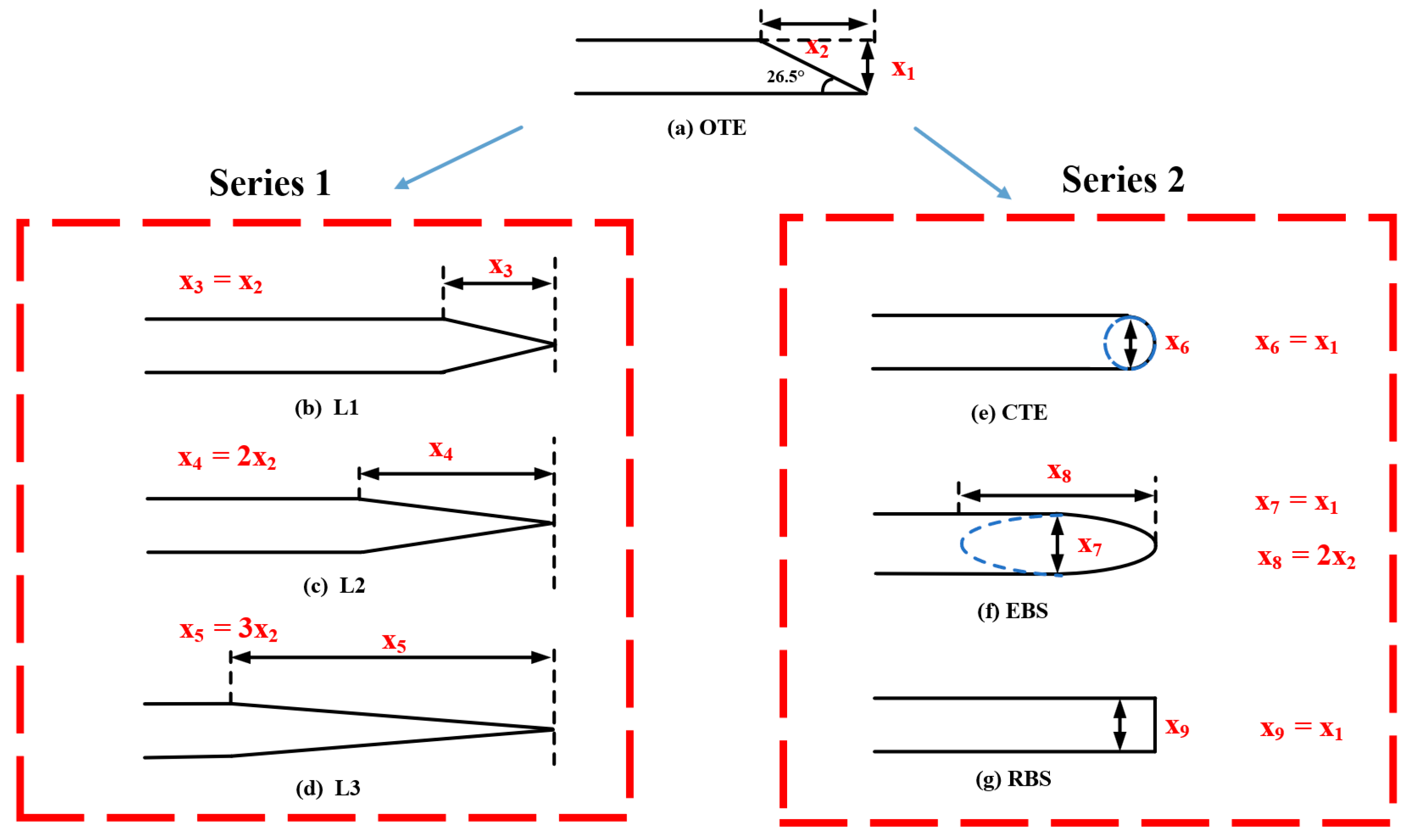
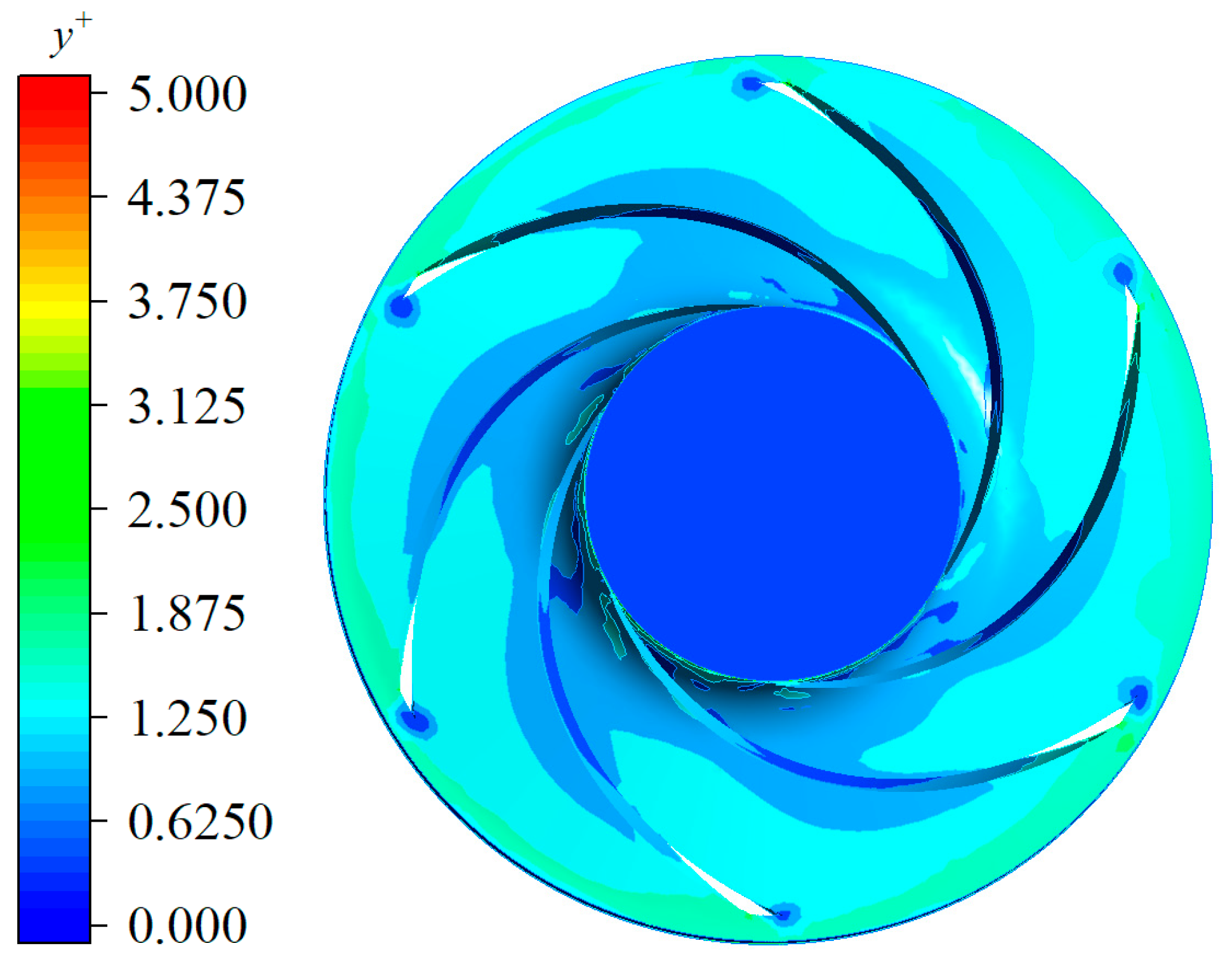

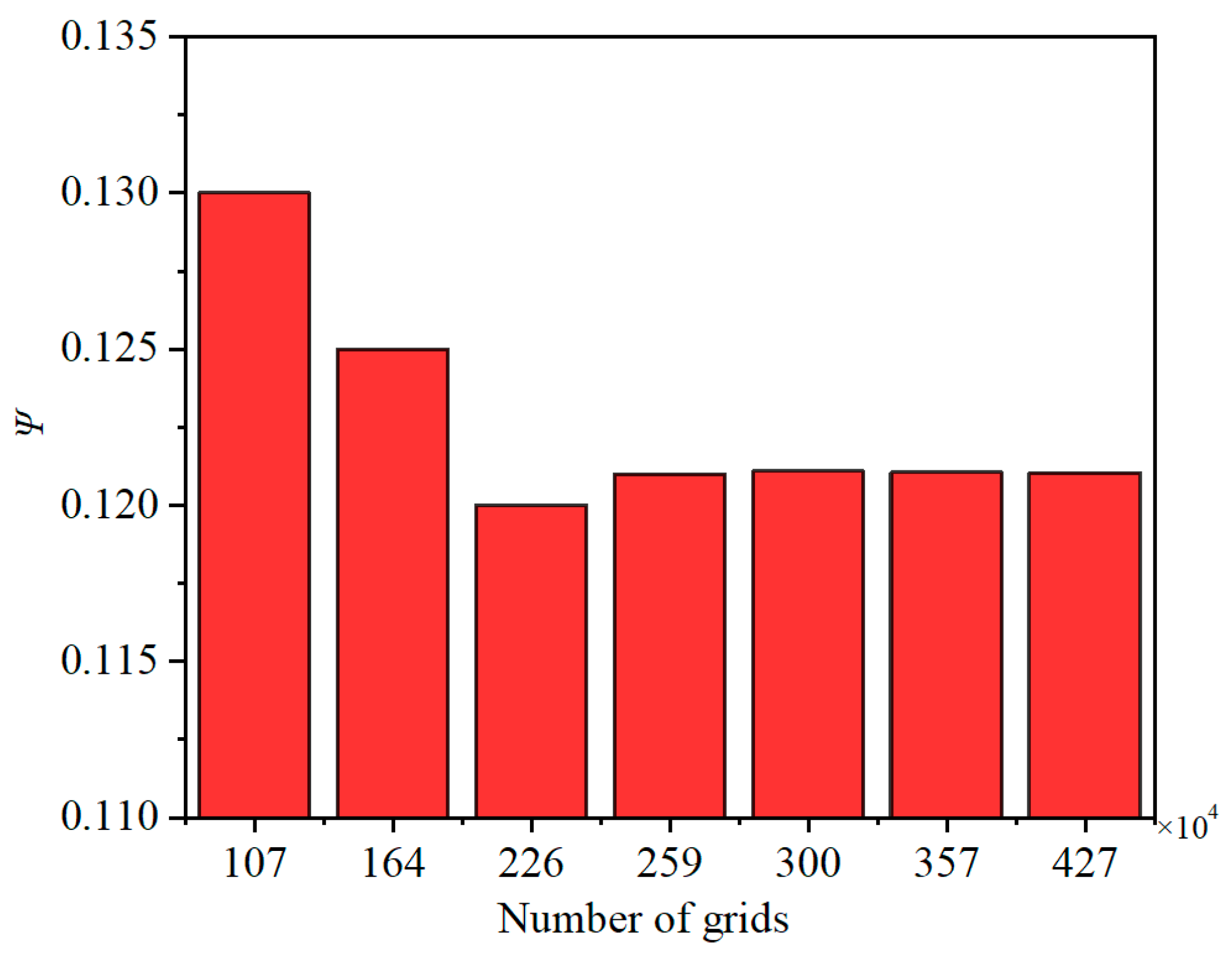
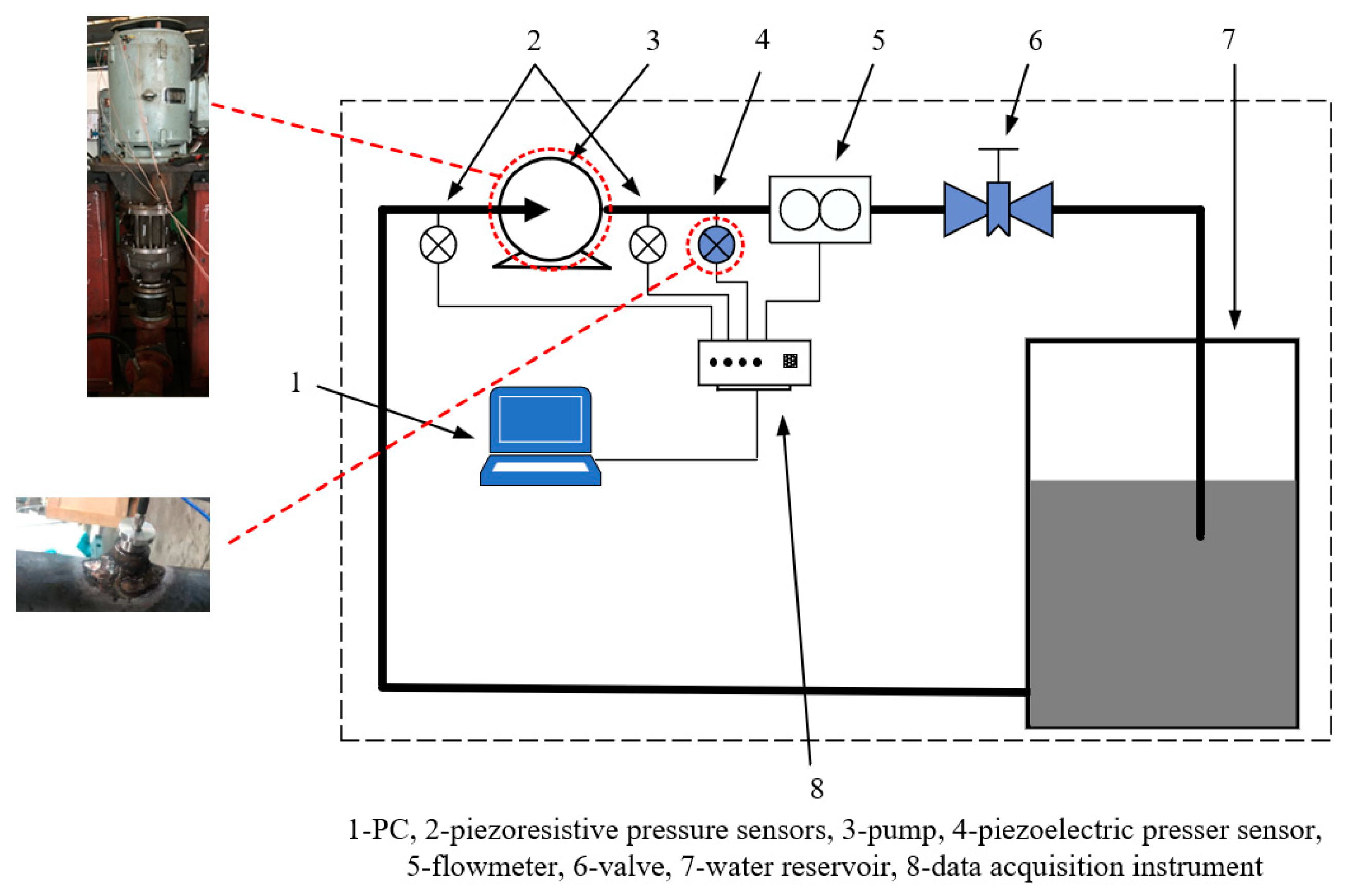
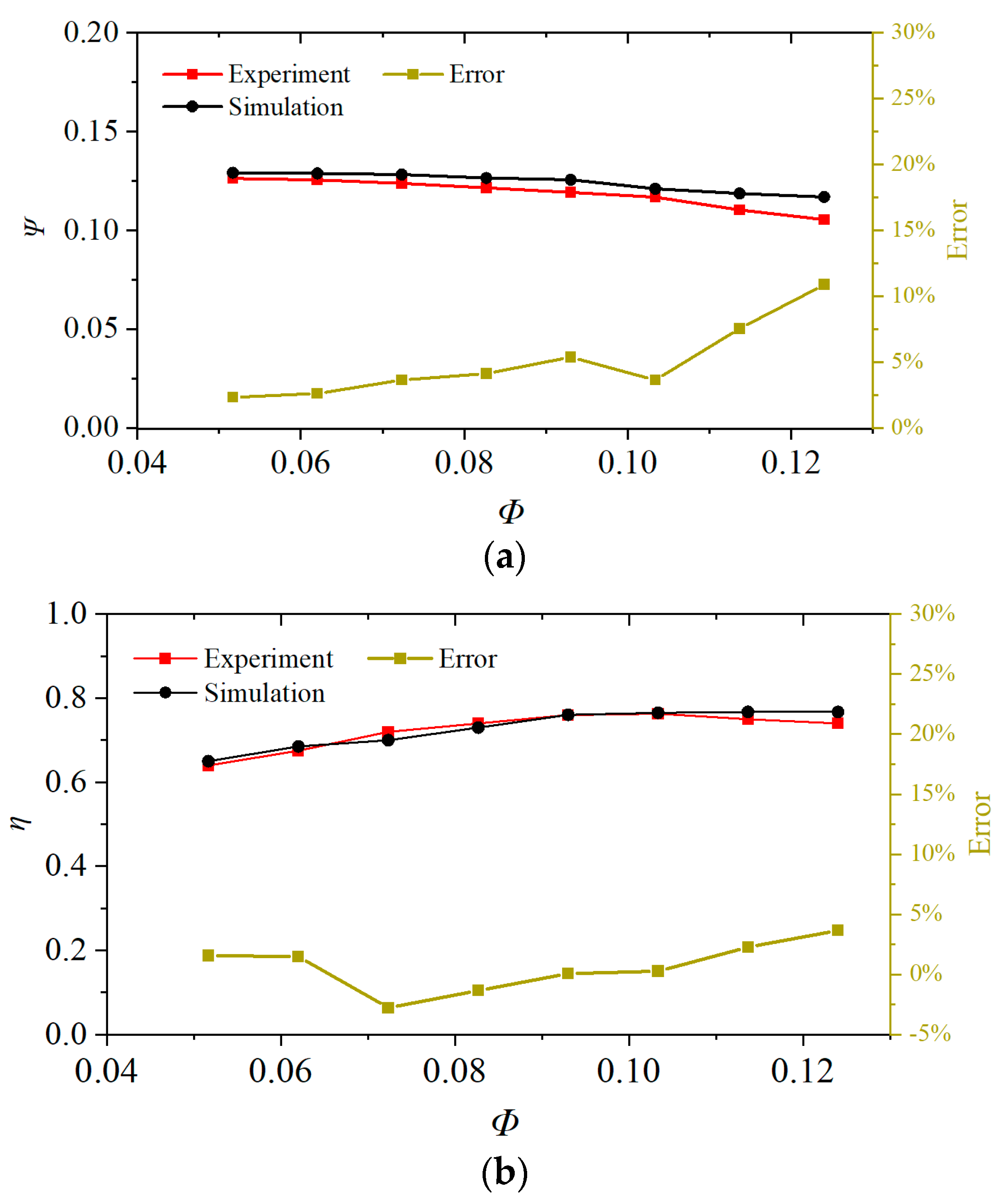
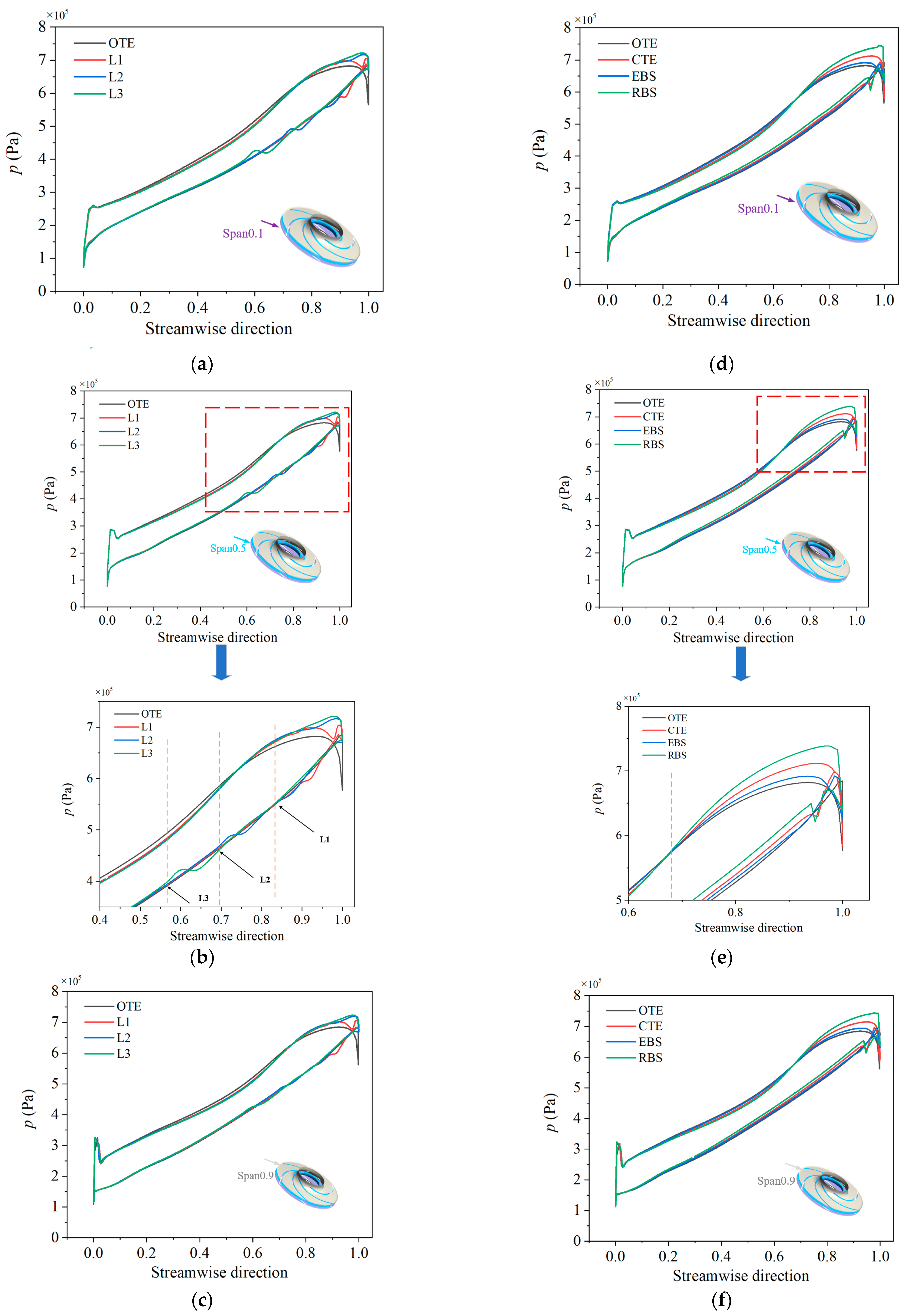

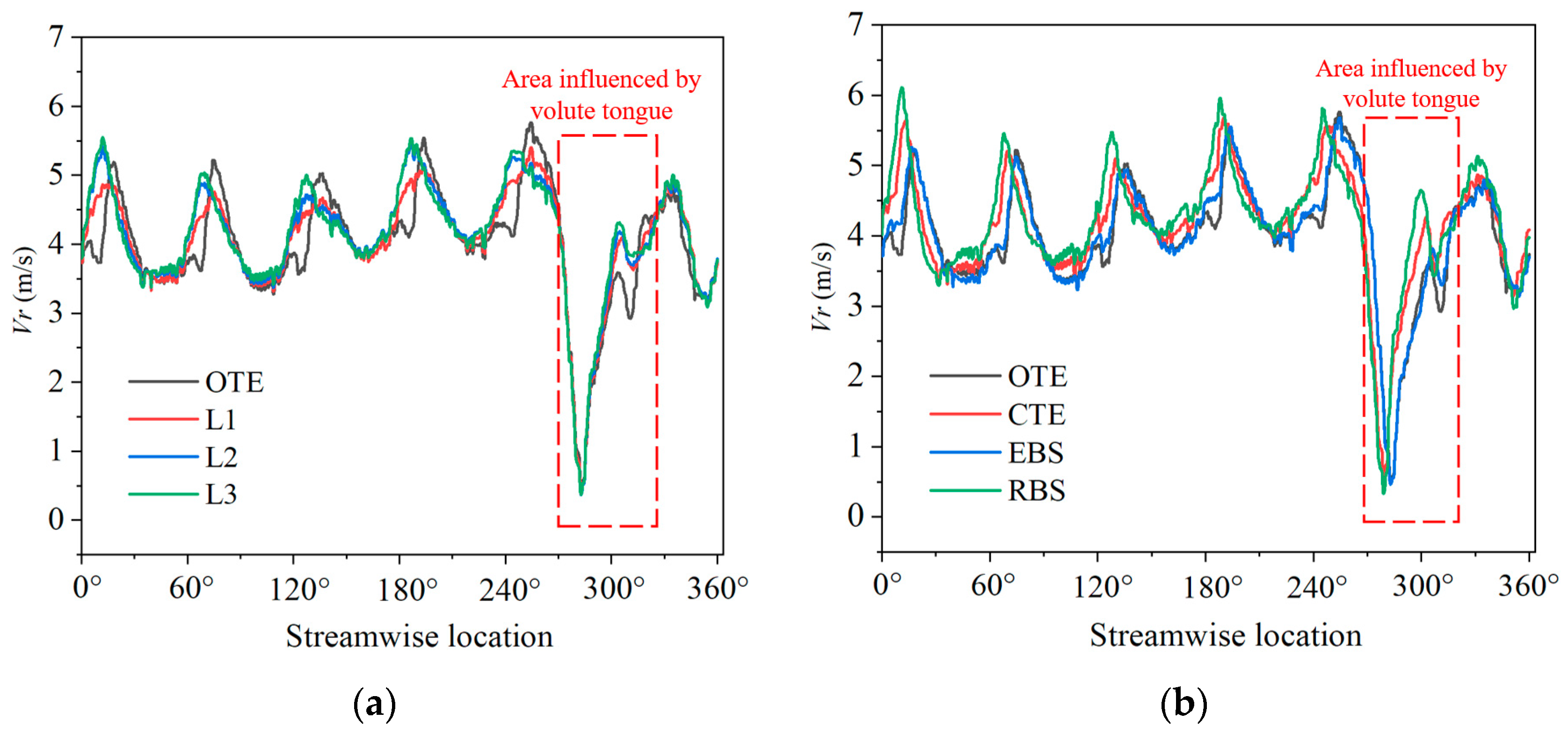
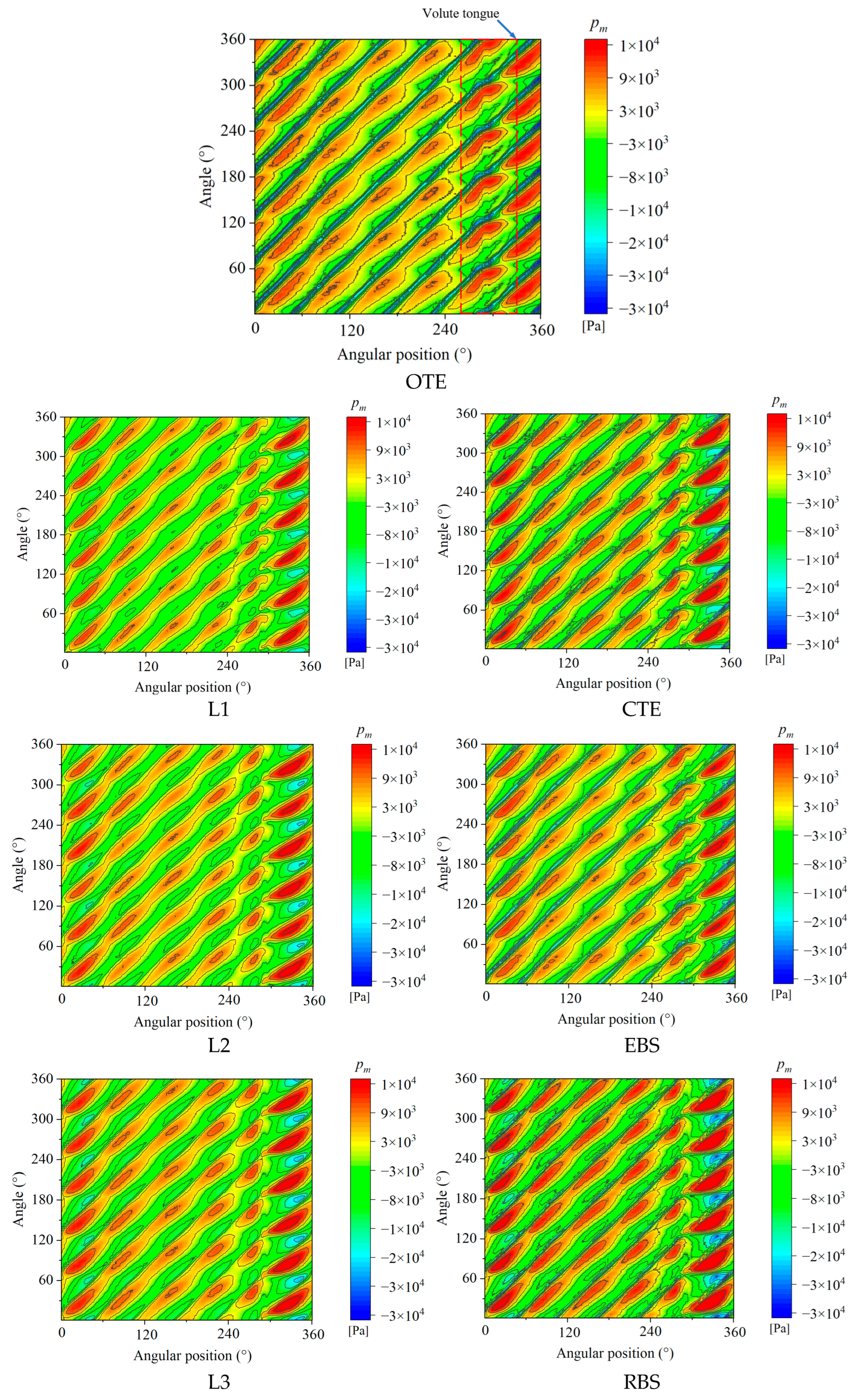

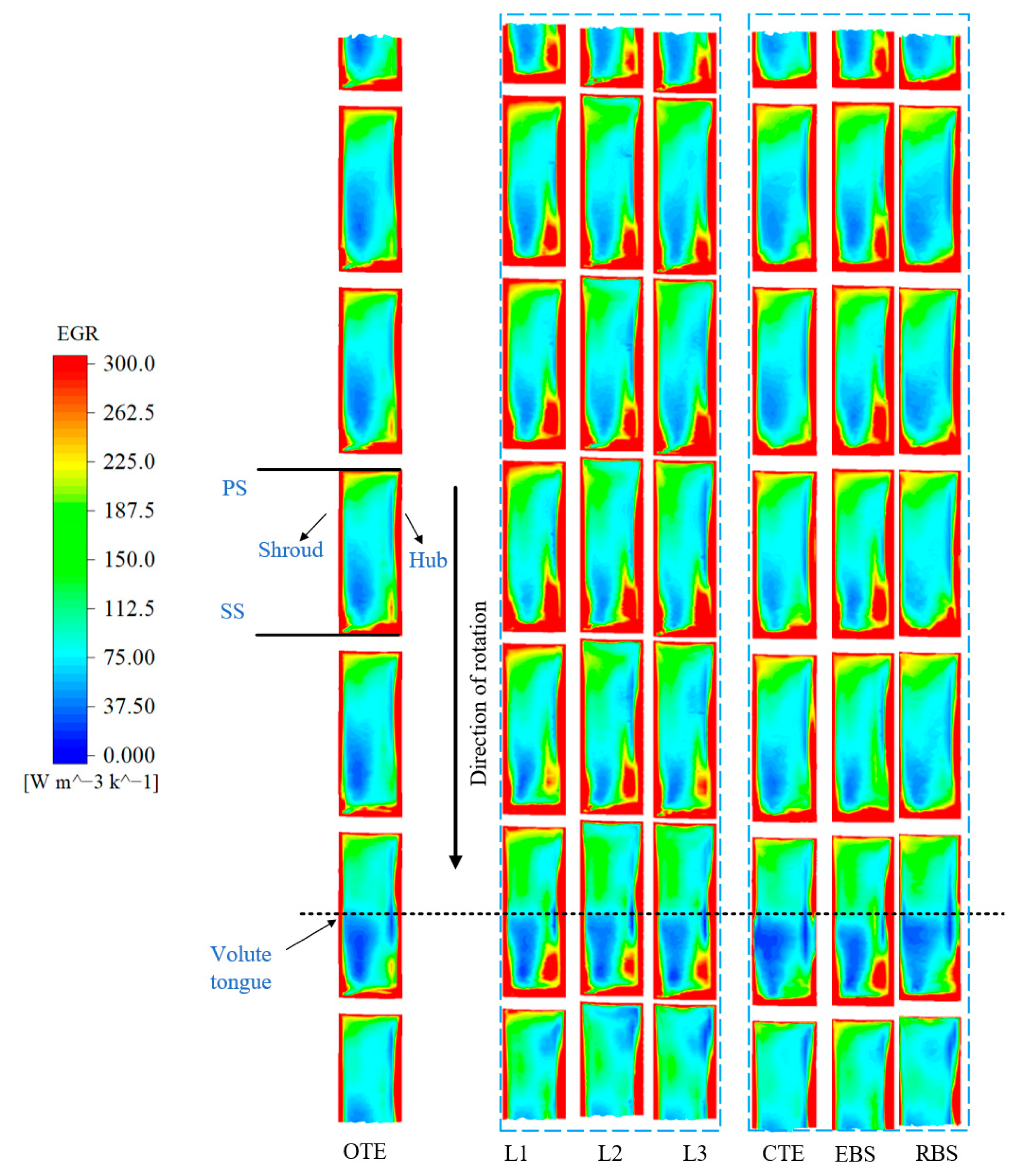
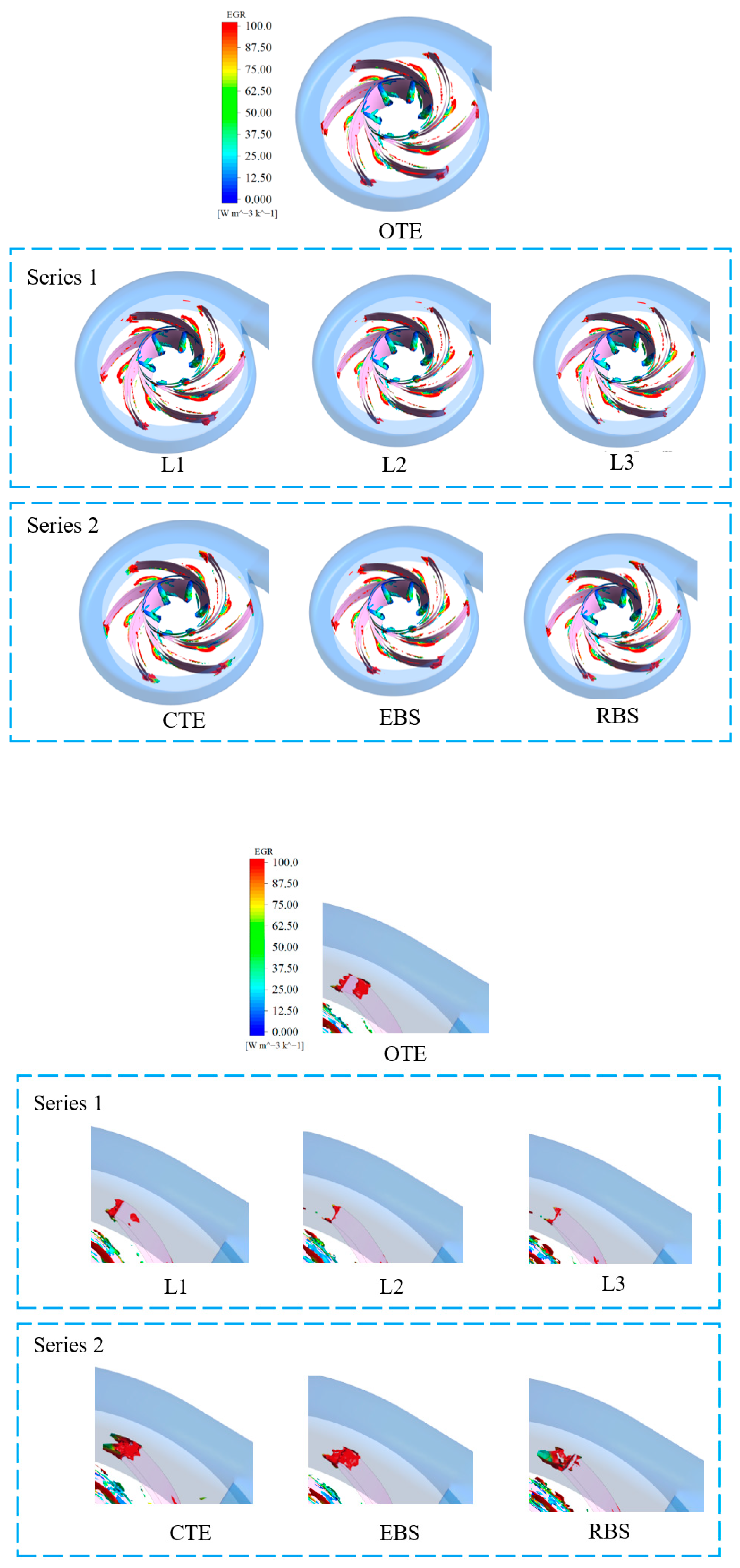
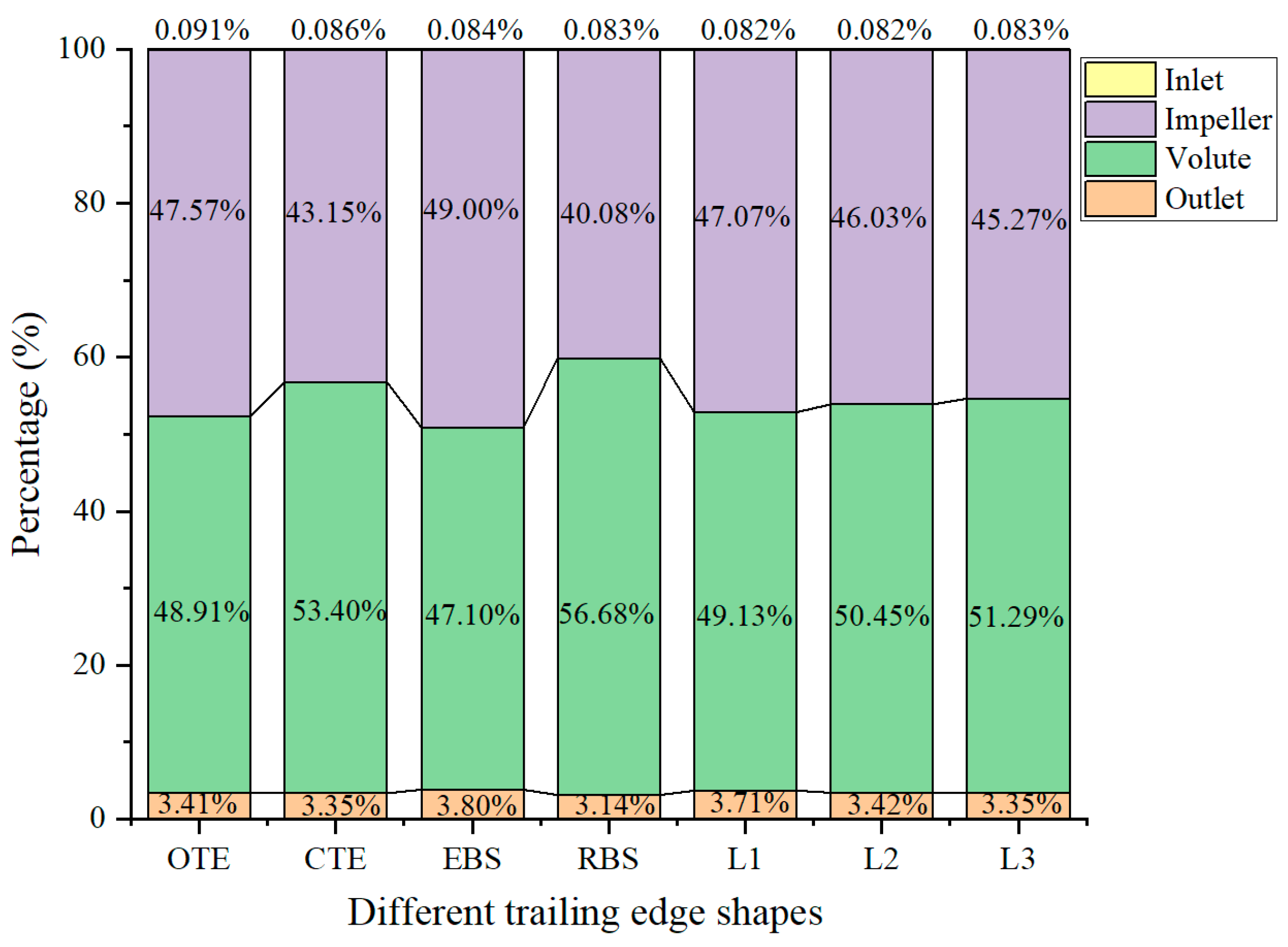
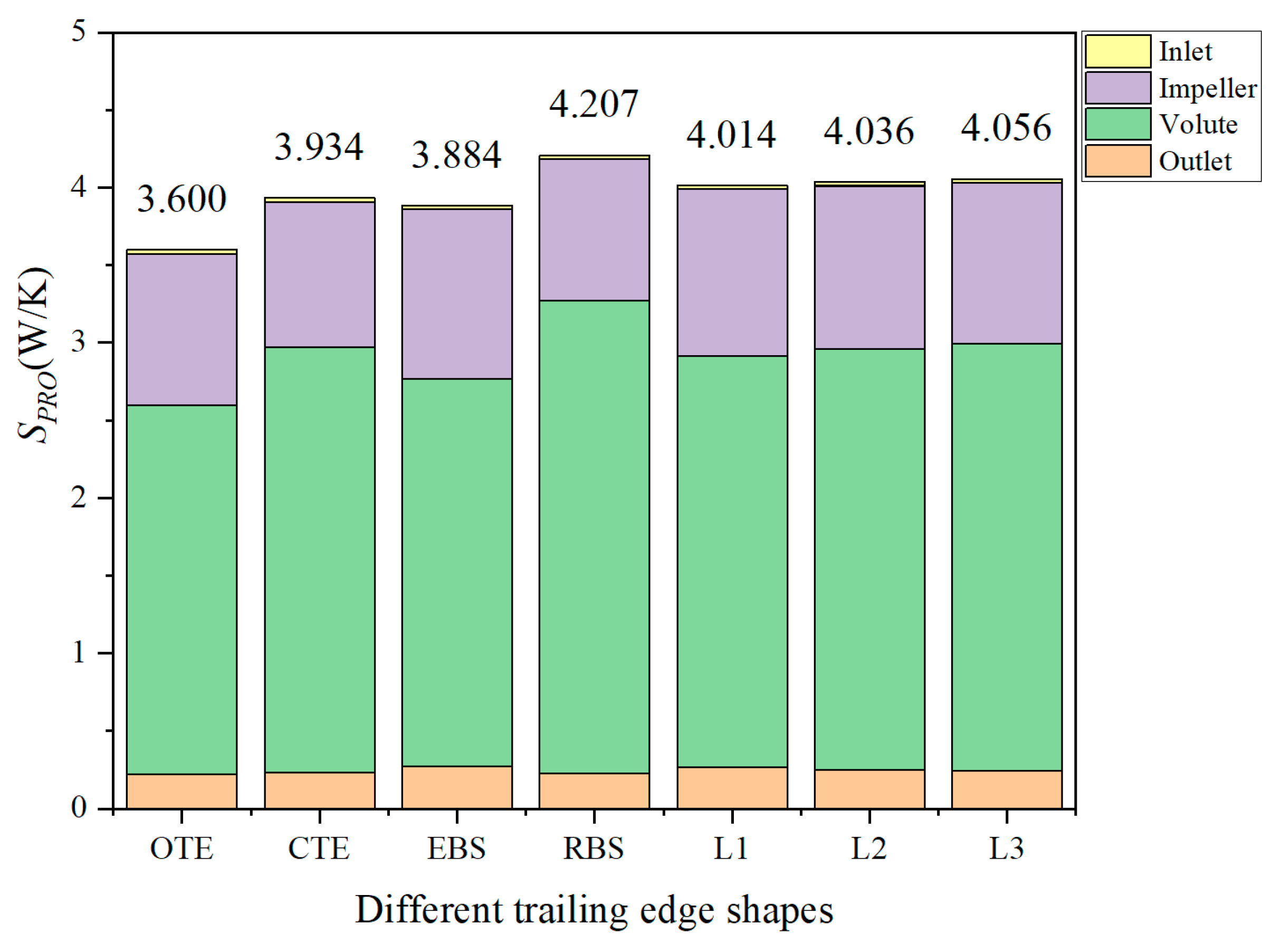
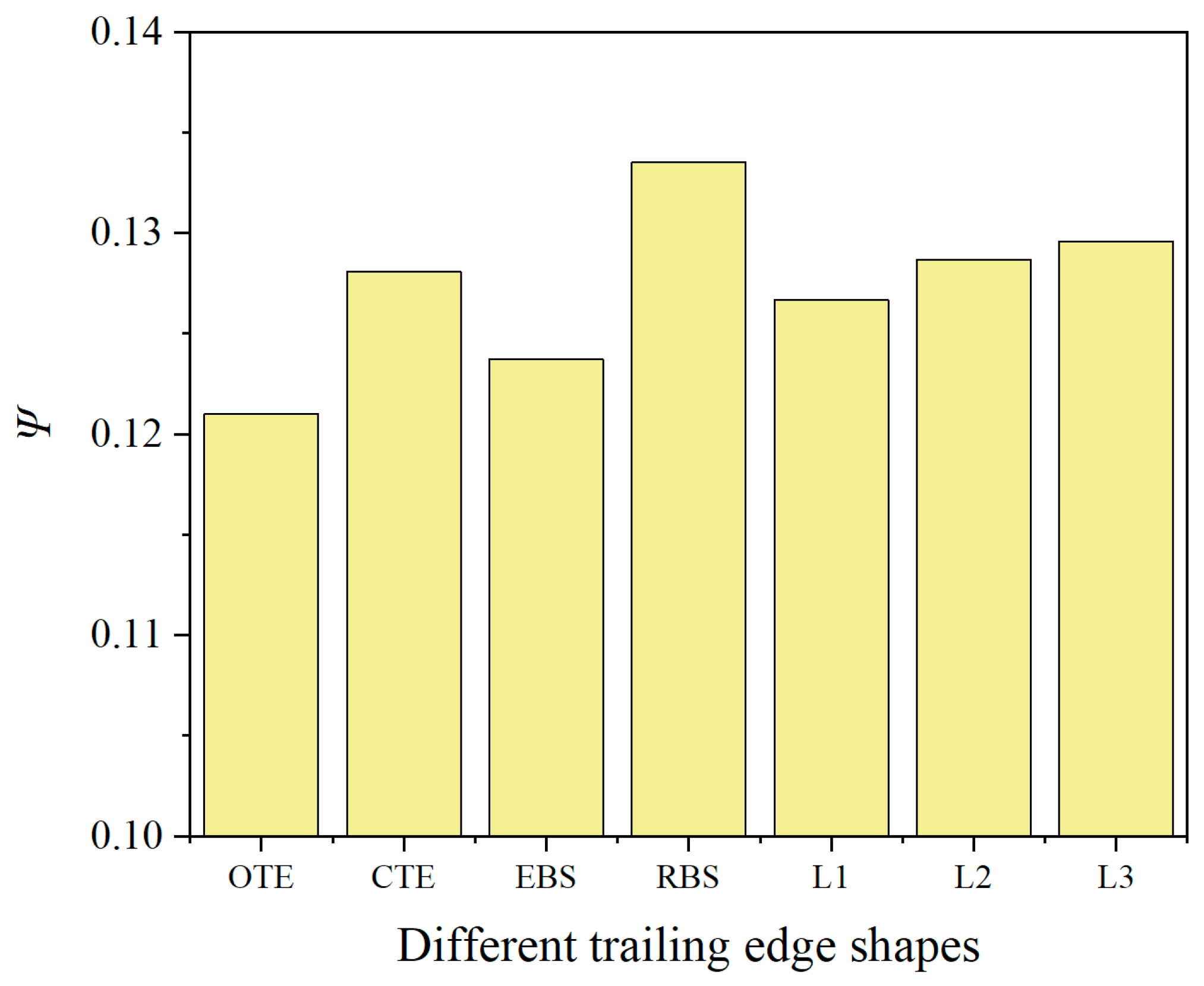
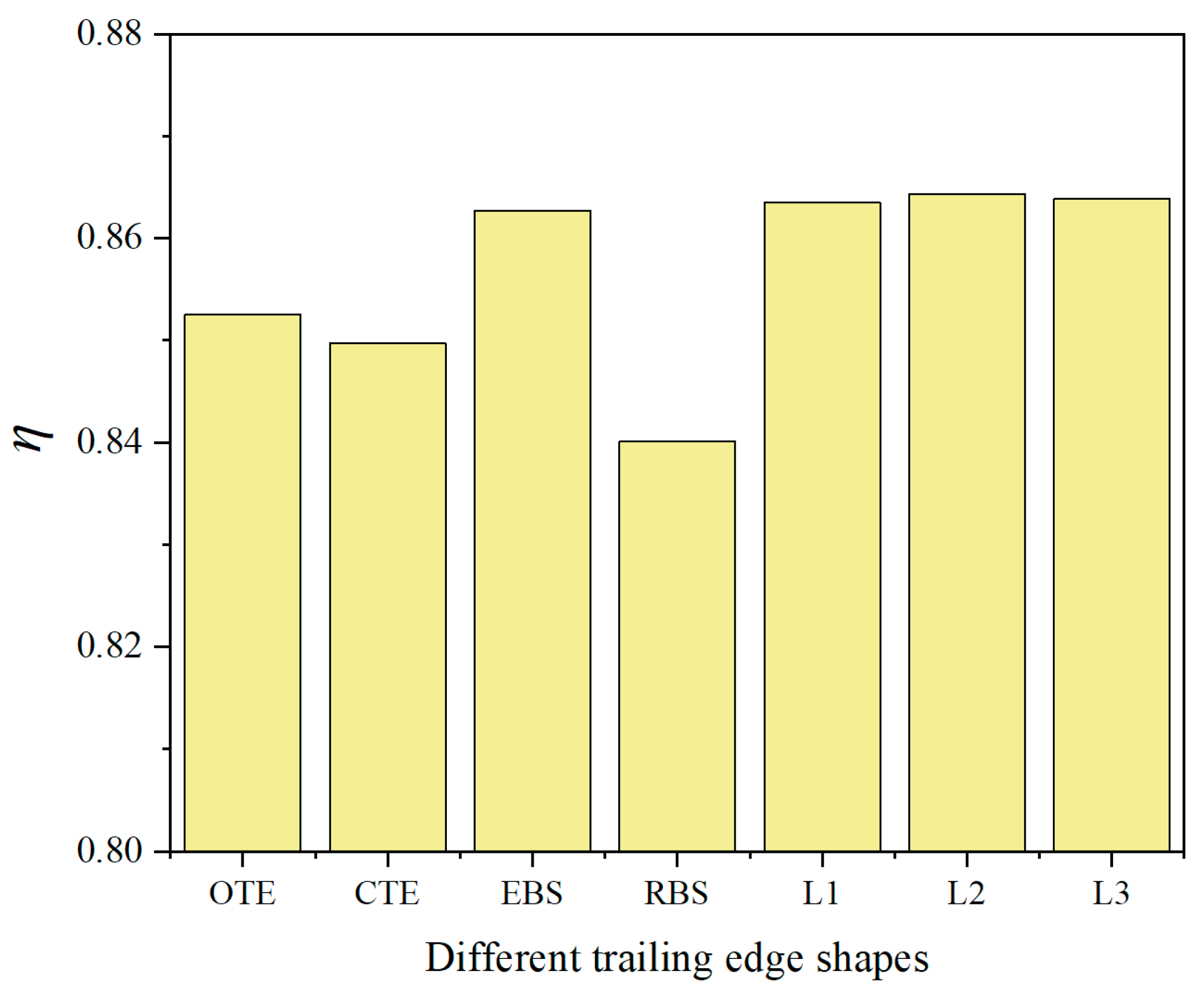
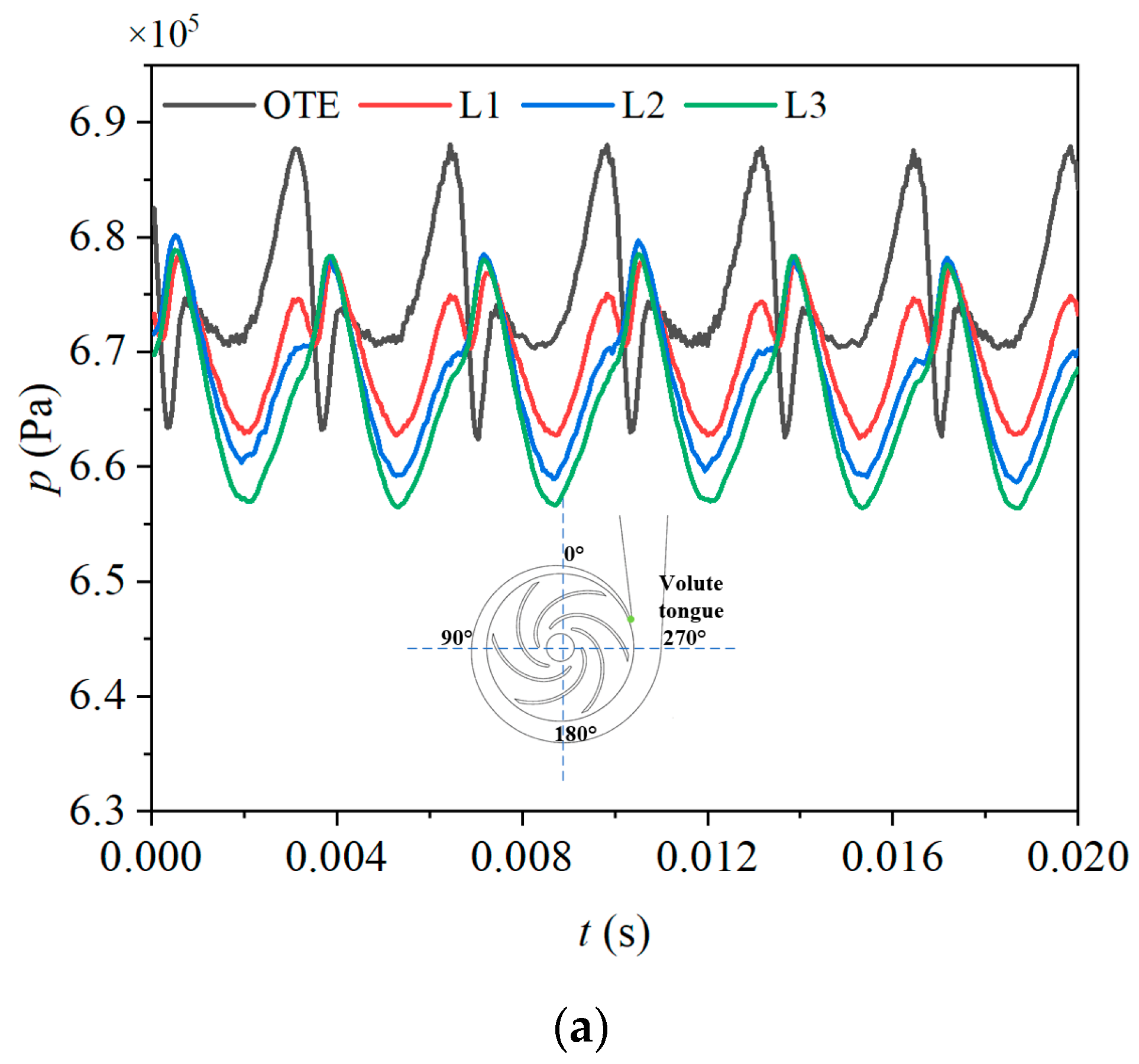

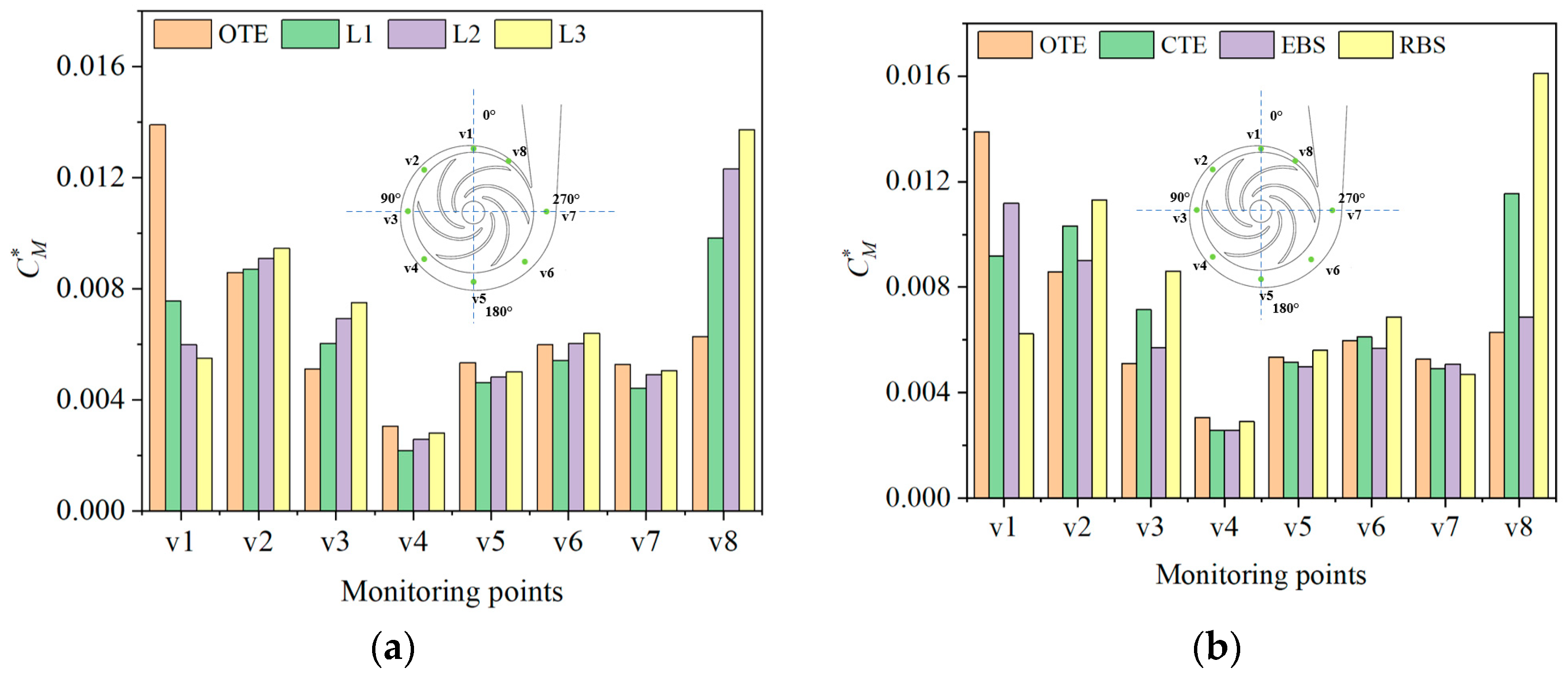
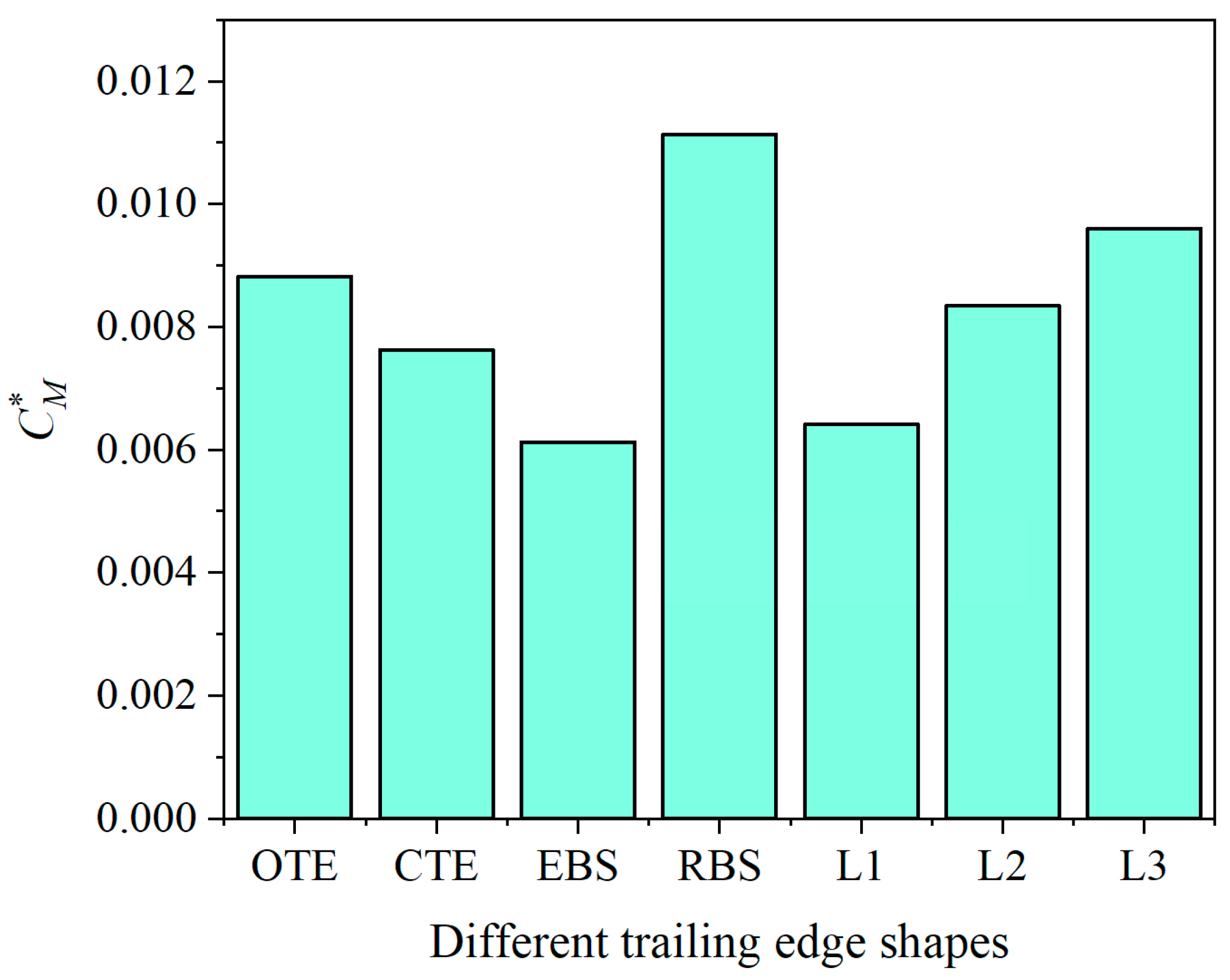
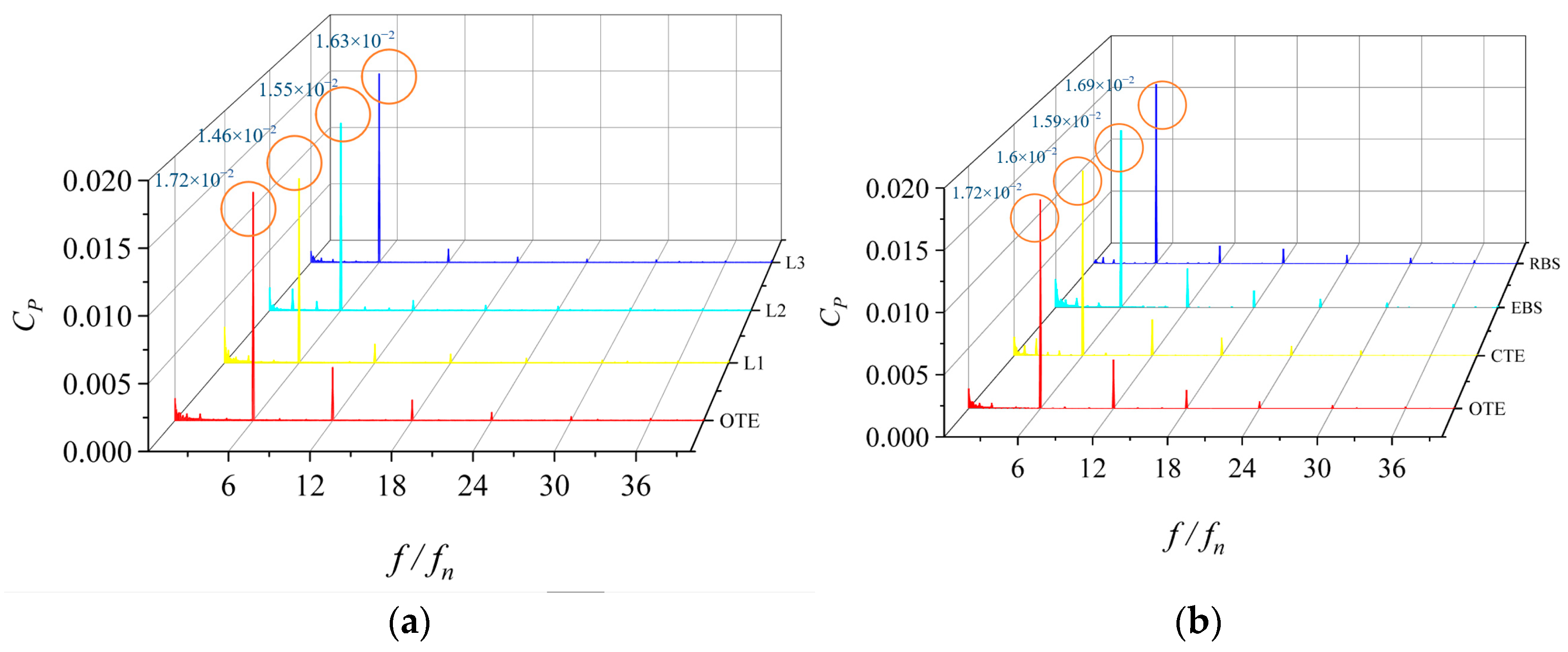
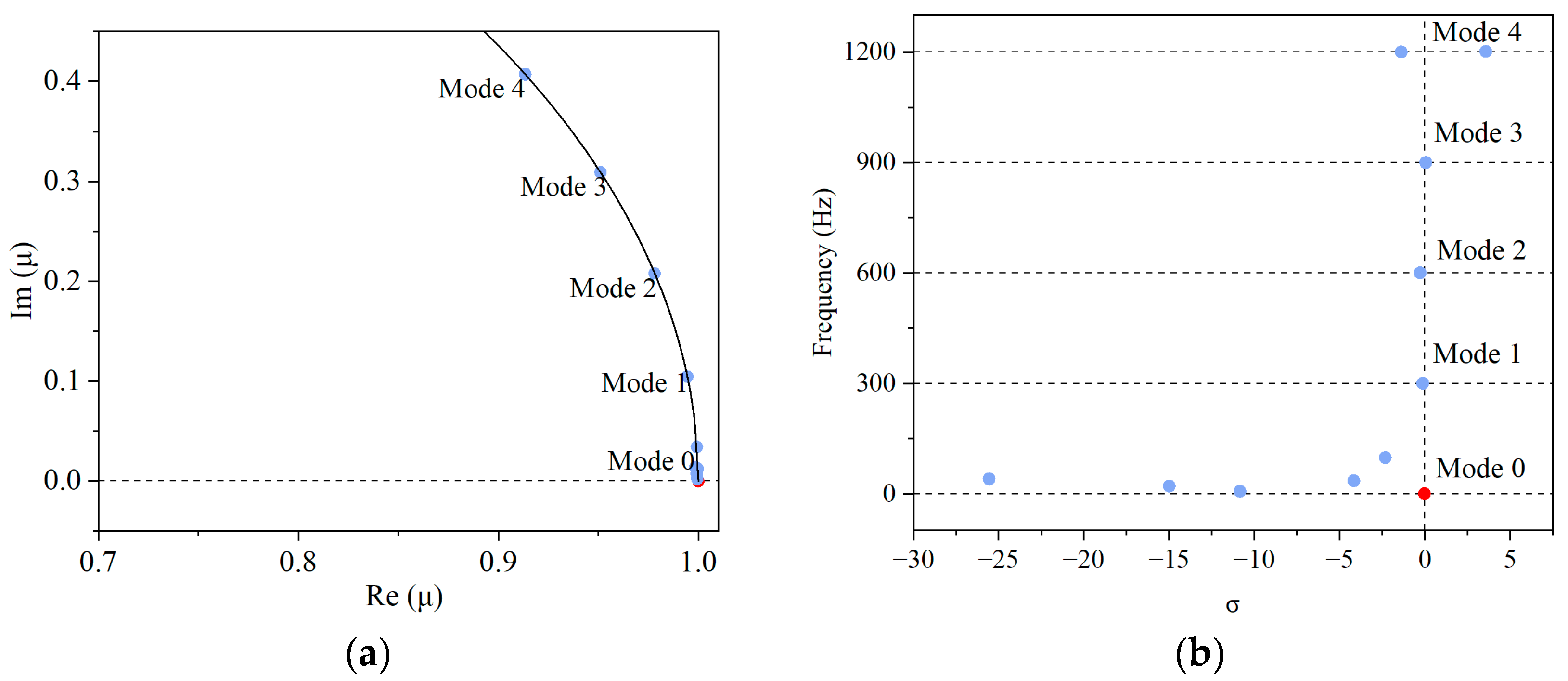

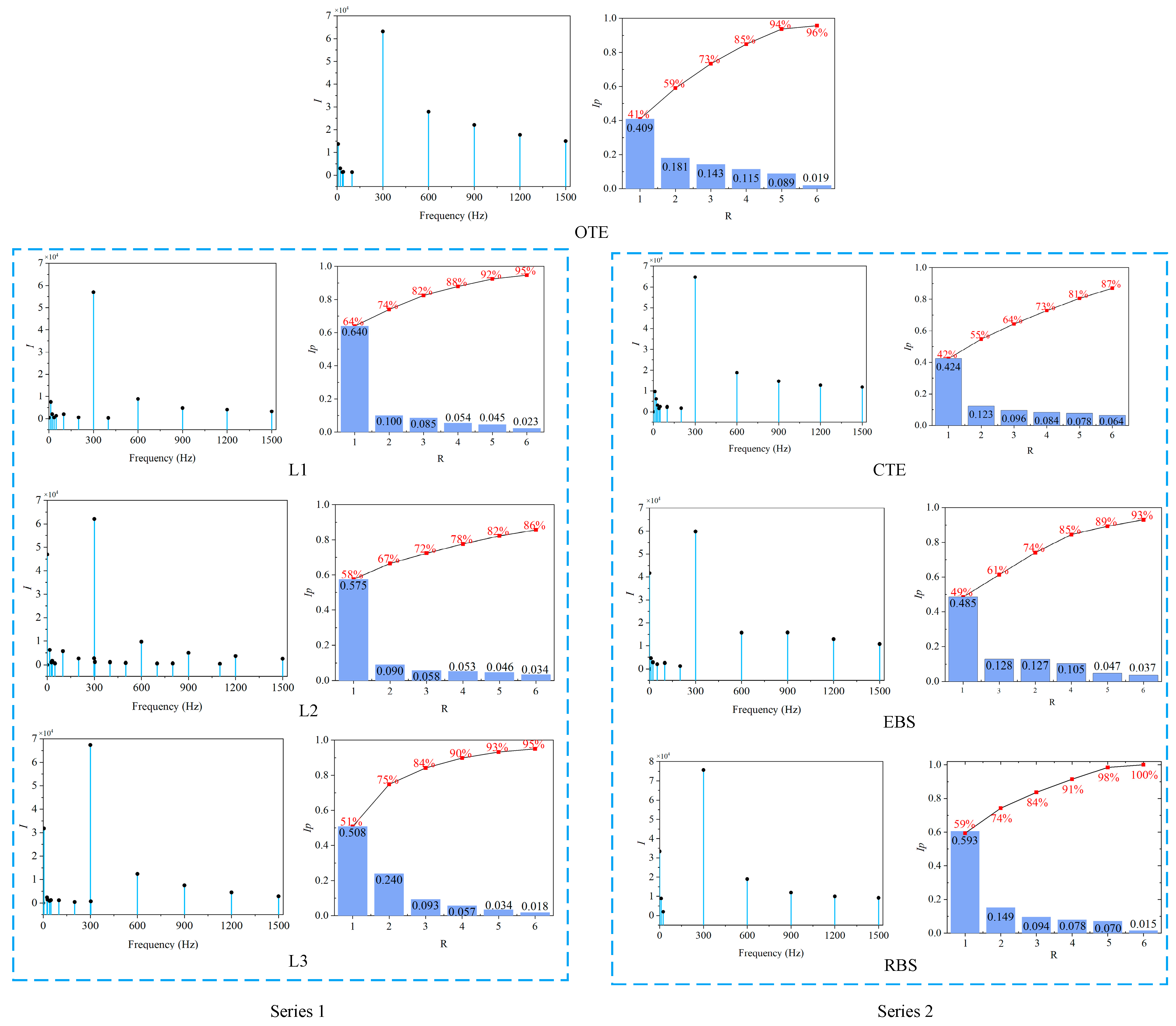



| Item | Value |
|---|---|
| Rotational speed, (rad/s) | 100π |
| Rotational frequency, fn (Hz) | 50 |
| Pump design head, (m) | 66.5 |
| Design flow rate, (m3/h) | 110 |
| Number of impeller blades, Z | 6 |
| Type number, K | 0.4257 |
| Diameter of inlet, Dj (mm) | 101 |
| Diameter of outlet, D2 (mm) | 238.7 |
| Outlet width of the impeller, b2 (mm) | 16.516 |
| Cap nut diameter, Dh (mm) | 53 |
| Different Trailing Edge Shapes | Item | Relationship or Value |
|---|---|---|
| OTE | x1 | 4.26 mm |
| OTE | Exit angle (α) | 26.5° |
| OTE | x2 | x2 = x1∙tanα |
| L1 | x3 | x3 = x1 |
| L2 | x4 | x4 = 2x1 |
| L3 | x5 | x5 = 3x1 |
| CTE | Radius (x6) | x6 = x1 |
| EBS | Minor axis (x7) | x7 = x1 |
| EBS | Major axis (x8) | x8 = 2x1 |
| RBS | x9 | x9 = x1 |
| Trailing Edge Type | |
|---|---|
| OTE | 14.2 |
| L1 | 12.57 |
| L2 | 13.46 |
| L3 | 13.89 |
| CTE | 14 |
| EBS | 14.2 |
| RBS | 15.36 |
| Trailing Edge Type | MSI of Mode 1 | MSI of Mode 2 |
|---|---|---|
| OTE | 0.1037 | 0.0697 |
| L1 | 0.0911 | 0.019 |
| L2 | 0.1022 | 0.021 |
| L3 | 0.1139 | 0.0286 |
| CTE | 0.1063 | 0.0441 |
| EBS | 0.096 | 0.0346 |
| RBS | 0.1323 | 0.0443 |
Disclaimer/Publisher’s Note: The statements, opinions and data contained in all publications are solely those of the individual author(s) and contributor(s) and not of MDPI and/or the editor(s). MDPI and/or the editor(s) disclaim responsibility for any injury to people or property resulting from any ideas, methods, instructions or products referred to in the content. |
© 2024 by the authors. Licensee MDPI, Basel, Switzerland. This article is an open access article distributed under the terms and conditions of the Creative Commons Attribution (CC BY) license (https://creativecommons.org/licenses/by/4.0/).
Share and Cite
Song, Z.; Chen, Y.; Yu, T.; Wang, X.; Cao, H.; Li, Z.; Lang, X.; Xu, S.; Lu, S.; Jiang, C. Influence of the Trailing Edge Shape of Impeller Blades on Centrifugal Pumps with Unsteady Characteristics. Processes 2024, 12, 508. https://doi.org/10.3390/pr12030508
Song Z, Chen Y, Yu T, Wang X, Cao H, Li Z, Lang X, Xu S, Lu S, Jiang C. Influence of the Trailing Edge Shape of Impeller Blades on Centrifugal Pumps with Unsteady Characteristics. Processes. 2024; 12(3):508. https://doi.org/10.3390/pr12030508
Chicago/Turabian StyleSong, Zhengkai, Yuxuan Chen, Tao Yu, Xi Wang, Haifeng Cao, Zhiqiang Li, Xiaopeng Lang, Simeng Xu, Shiyi Lu, and Chenxing Jiang. 2024. "Influence of the Trailing Edge Shape of Impeller Blades on Centrifugal Pumps with Unsteady Characteristics" Processes 12, no. 3: 508. https://doi.org/10.3390/pr12030508





